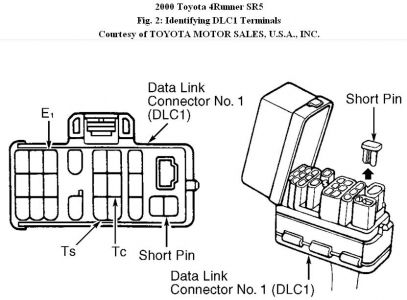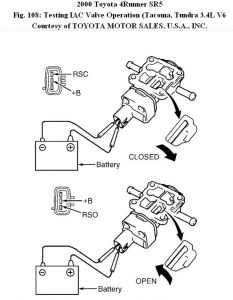When the ABS indicator light turns on, it means a fault in the ABS system has been detected and trouble codes are stored in the ABS control module. The ABS has been disabled under such circumstances.
You would need to retrieve the trouble code to find out what is causing it.
RETRIEVING DTCS
NOTE:
Speed sensor diagnostics and code retrieval use different DLC1 terminals with short pin connected. If a speed sensor circuit problem is suspected, see SPEED SENSOR DIAGNOSTICS .
ABS Warning Light Diagnostics
1. Ensure battery is fully charged. Turn ignition on. ABS warning light should illuminate, then turn off after 3 seconds.
2. Remove short pin from DLC1. DLC1 is located in engine compartment on left side of engine. See Fig. 2 . Using a fused jumper wire, jumper DLC1 terminals Tc and E1 . If a malfunction is detected, 4 seconds will elapse and ABS warning light will begin to flash a 2-digit DTC. First number of flashes equal first digit in DTC. After a 1.5-second pause, second number of flashes equal second digit in DTC.
3. If 2 or more DTCs are stored, there will be a 2.5-second pause between each DTC. After all DTCs are flashed, there will be a 4-second pause and all DTCs will repeat. If ABS system is functioning properly, ABS warning light will flash 2 times per second. For DTC definitions, see DTC IDENTIFICATION table. For diagnostic testing procedures, see DIAGNOSTIC
TESTS .
4. After replacing or repairing components, clear DTCs. If a battery cable was disconnected during repairs, all DTCs will be erased. If battery cable was not disconnected during repairs, see CLEARING DTCS .


SPEED SENSOR DIAGNOSTICS
NOTE: While diagnosing speed sensors, brake system functions as a conventional system.
1. Ensure battery is fully charged. Turn ignition on. Ensure ABS warning light illuminates, then turns off after about 3 seconds.
2. Turn ignition off. DO NOT remove short pin from DLC1. Using a fused jumper wire, jumper terminals Ts and E1 of DLC1. DLC1 is located in left side of engine compartment. See Fig. 2 . Apply parking brake. Start engine. Ensure ABS warning light flashes 4 times per second. If ABS warning light does not flash, go to ABS WARNING LIGHT CIRCUIT under CIRCUIT TESTS. If ABS warning light flashes, go to next step.
3. Drive vehicle at speeds greater than 28 MPH for several seconds. Stop vehicle. Jumper terminals Tc and E1 of DLC1. See Fig. 2 . If all sensors are okay, a normal DTC is displayed (ABS warning light flashes 2 times per second). If a malfunction is detected, 4 seconds will elapse and ABS warning light will begin to flash a 2-digit DTC. First number of flashes equal first digit in DTC. After a 1.5-second pause, second number of flashes equal second digit in DTC.
4. If 2 or more DTCs are stored, there will be a 2.5-second pause between each DTC. After all DTCs are flashed, there will be a 4-second pause and all DTCs will repeat.
5. Record DTCs. Turn ignition off. Repair as necessary. See SPEED SENSOR DTC IDENTIFICATION . Remove jumper wires from DLC1. Clear DTCs. See CLEARING
DTCS .

CLEARING DTCS
NOTE: DTCs can also be cleared by removing ECU-B fuse (7.5-amp), located in instrument panel fuse block. However, memory for other electronic systems will be lost.
1. Remove short pin from DLC1. DLC1 is located in left side of engine compartment. See Fig. 2 . Using a fused jumper wire, jumper DLC1 terminals Tc and E1 . Turn ignition on. Depress brake pedal 8 or more times within 3 seconds. Ensure ABS warning light flashes 2 times per second. Reconnect short pin.
Wednesday, November 10th, 2010 AT 8:47 AM







